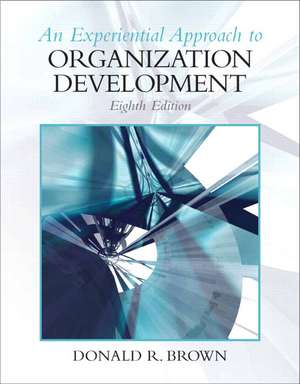An Experiential Approach to Organization Development
Autor Donald R. Brownen Limba Engleză Paperback – 31 dec 2009
With a focus on the development of readers interpersonal skills, " Experiential Approach to Organization Development "provides a comprehensive, realistic, innovative, and practical introduction to the field.
The eighth edition presents new and revised information, keeping the material fresh and relevant.
"
Preț: 1184.37 lei
Preț vechi: 1538.13 lei
-23% Nou
Puncte Express: 1777
Preț estimativ în valută:
226.68€ • 235.74$ • 189.68£
226.68€ • 235.74$ • 189.68£
Carte disponibilă
Livrare economică 21 februarie-07 martie
Preluare comenzi: 021 569.72.76
Specificații
ISBN-13: 9780136106890
ISBN-10: 0136106897
Pagini: 454
Dimensiuni: 213 x 272 x 23 mm
Greutate: 0.89 kg
Ediția:8Nouă
Editura: Prentice Hall
Locul publicării:Upper Saddle River, United States
ISBN-10: 0136106897
Pagini: 454
Dimensiuni: 213 x 272 x 23 mm
Greutate: 0.89 kg
Ediția:8Nouă
Editura: Prentice Hall
Locul publicării:Upper Saddle River, United States
Descriere
For courses in Organization Development, Organizational Behavior and Organizational Change.
A conceptual and experiential approach to understanding organizational development.
With a focus on the development of students’ interpersonal skills,Experiential Approach to Organization Development provides a comprehensive, realistic, innovative, and practical introduction to the field.
The eighth edition presents new and revised information to help keep course material fresh and relevant.
A conceptual and experiential approach to understanding organizational development.
With a focus on the development of students’ interpersonal skills,Experiential Approach to Organization Development provides a comprehensive, realistic, innovative, and practical introduction to the field.
The eighth edition presents new and revised information to help keep course material fresh and relevant.
Cuprins
Part 1: ANTICIPATING CHANGE
Chapter 1. Organizational Development and Reinventing the Organization
Chapter 2. Organization Renewal: The Challenge of Change
Chapter 3. Changing the Culture
Part 2: UNDERSTANDING THE OD PROCESS
Chapter 4. Role and Style of the OD Practitioner
Chapter 5. The Diagnostic Process
Chapter 6. Overcoming Resistance to Change
Part 3 IMPROVING EXCELLENCE IN INDIVIDUALS
Chapter 7. OD Intervention Strategies
Chapter 8. Process Intervention Skills
Chapter 9. Employee Empowerment and Interpersonal Interventions
Part 4: DEVELOPING HIGH PERFORMANCE IN TEAMS
Chapter 10. Team Development Interventions
Chapter 11. Intergroup Development
Chapter 12. Goal Setting for Effective Organizations
Chapter 13. Work Team Development
Part 5: BUILDING SUCCESS IN ORGANIZATIONS
Chapter 14. High-Performing Systems and the Learning Organization
Chapter 15. Organization Transformation and Strategic Change
Chapter 16. The Challenge and the Future for Organizations
Caracteristici
For courses in Organization Development, Organizational Behavior and Organizational Change.
A conceptual and experiential approach to understanding organizational development.
With a focus on the development of students’ interpersonal skills,Experiential Approach to Organization Development provides a comprehensive, realistic, innovative, and practical introduction to the field.
The eighth edition presents new and revised information to help keep course material fresh and relevant.
Get students involved in the learning process: An experiential approach. This text motivates students to take an active role in learning organization development (OD) by encouraging them to get involved in what to do, and how to do it. Brown effectively caters to this experiential approach by presenting material that adheres to three basic concepts:
Offer a variety of support: Learning aids. This text provides a variety of visual, strategic, and informative learning aids to assist students’ as they learn:
NEW! Incorporate currency: Approximately 35% of the material is new or revised. Today’s managers are confronting an accelerating rate of change. They face constant innovation in computer and information technology, and a chaotic world of changing markets and consumer lifestyles. This text helps to keep future managers ahead of the curve by presenting the latest in OD trends with updated content and new research.
Present a logical succession: A practical organization. To help students easily grasp the material, this text presents topics in a logical progression, moving seamlessly from the basic elements to the complex. The five parts that reflect this progression are:
Part 1: Anticipating change
Part 2: Understanding the OD Process
Part 3: Improving Excellence in Individuals
Part 4: Developing High Performance Teams
Part 5: Building Success in OrganizationsNEW! Appeal to visual learners: New illustrations have been added. The visual perspective of this text continues with the addition of new illustrations that include instructions, forms, and tables.
A conceptual and experiential approach to understanding organizational development.
With a focus on the development of students’ interpersonal skills,Experiential Approach to Organization Development provides a comprehensive, realistic, innovative, and practical introduction to the field.
The eighth edition presents new and revised information to help keep course material fresh and relevant.
Get students involved in the learning process: An experiential approach. This text motivates students to take an active role in learning organization development (OD) by encouraging them to get involved in what to do, and how to do it. Brown effectively caters to this experiential approach by presenting material that adheres to three basic concepts:
- Students learn best when involved in the learning experience.
- As a “Learner,” students have to experience or discover concepts, if they are to change behavior.
- A students’ commitment to learning increases when they are responsible for setting their own learning objectives.
Offer a variety of support: Learning aids. This text provides a variety of visual, strategic, and informative learning aids to assist students’ as they learn:
- Chapter objectives are provided in each chapter, where they present a brief list of learning goals to help students prepare for the reading.
- A pre-class preparation feature appears on the first page of a chapter and lists exactly what students need to do to prepare for class.
- New illustrations, including figures and tables, have been added throughout the chapter, highlighting key concepts, theories, and applications with strong visual materials.
- OD applications provide information about how large organizations, such as Google and P&G, and smaller less well-known organizations, like Setpoint Systems and the Chugach School District, are applying the OD concepts or interventions discussed in the chapter.
- Current examples of business practices appear throughout the text.
- Summaries. Each chapter concludes with a summary that wraps up the main points and concepts.
- Review questions cover the main chapter points and provide students with an opportunity to test their knowledge.
- Key terms are highlighted within the chapters to help students identify definitions within context.
- OD skills simulations are self-learning, experiential exercises that include both individual and team learning. The exercises take theories and principles covered in the text and bring them to life in team activities.
- Case studies appear at the end of each chapter for class discussion or written assignment.
- References are documented to allow for additional research.
NEW! Incorporate currency: Approximately 35% of the material is new or revised. Today’s managers are confronting an accelerating rate of change. They face constant innovation in computer and information technology, and a chaotic world of changing markets and consumer lifestyles. This text helps to keep future managers ahead of the curve by presenting the latest in OD trends with updated content and new research.
Present a logical succession: A practical organization. To help students easily grasp the material, this text presents topics in a logical progression, moving seamlessly from the basic elements to the complex. The five parts that reflect this progression are:
Part 1: Anticipating change
Part 2: Understanding the OD Process
Part 3: Improving Excellence in Individuals
Part 4: Developing High Performance Teams
Part 5: Building Success in OrganizationsNEW! Appeal to visual learners: New illustrations have been added. The visual perspective of this text continues with the addition of new illustrations that include instructions, forms, and tables.
Caracteristici noi
NEW! Incorporate currency: Approximately 35% of the material is new or revised. Today’s managers are confronting an accelerating rate of change. They face constant innovation in computer and information technology, and a chaotic world of changing markets and consumer lifestyles. This text helps to keep future managers ahead of the curve by presenting the latest in OD trends with updated content and new research.
NEW! Appeal to visual learners: New illustrations have been added. The visual perspective of this text continues with the addition of new illustrations that include instructions, forms, and tables.
NEW! Appeal to visual learners: New illustrations have been added. The visual perspective of this text continues with the addition of new illustrations that include instructions, forms, and tables.









